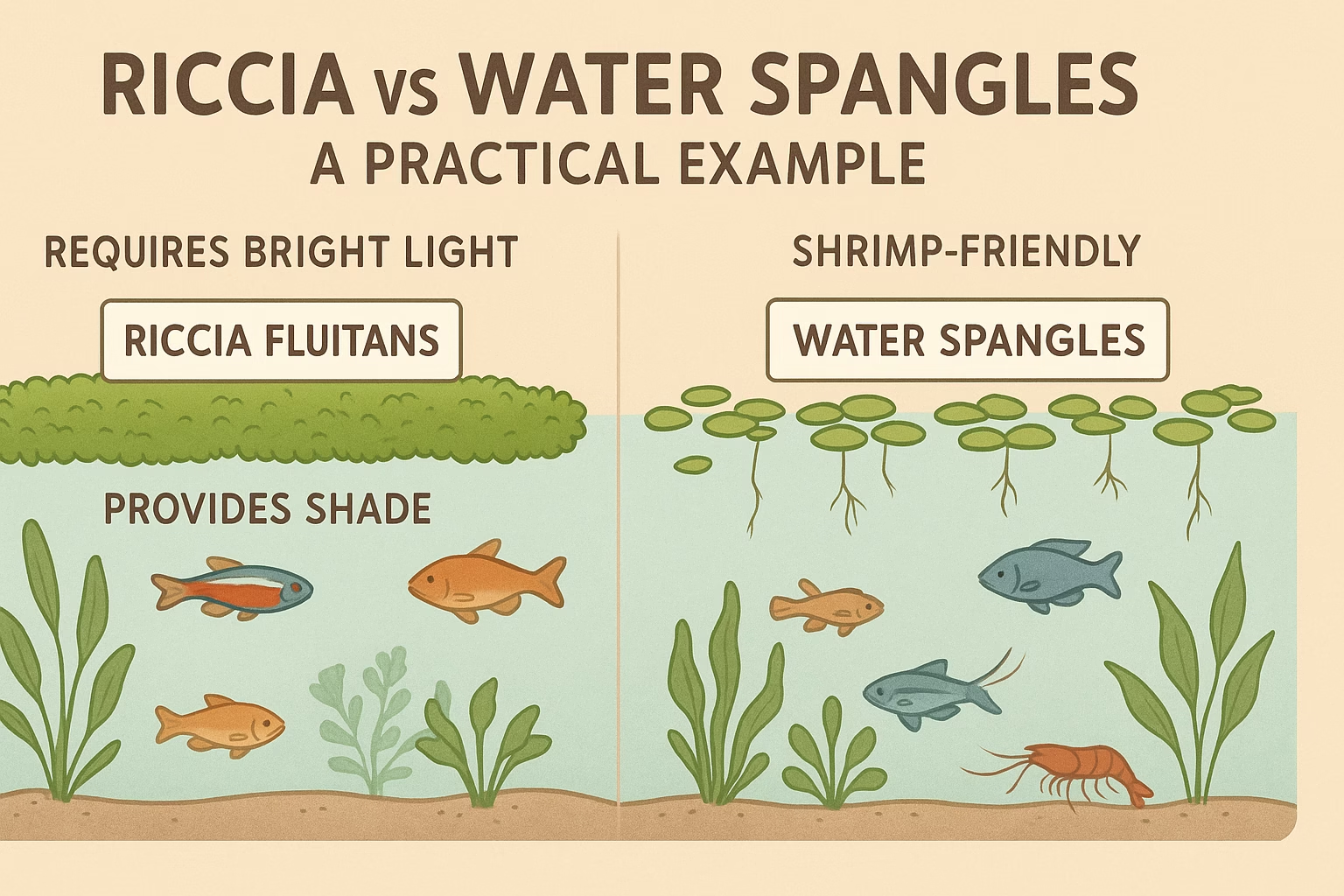
Choosing the right floating plant can significantly impact the health and aesthetics of your aquarium. Two popular options among aquarists are Riccia fluitans (commonly known as Riccia) and Salvinia minima (commonly known as Water Spangles). Both are attractive, useful, and beginner-friendly, but they serve different roles in a tank. This guide explores the differences, care requirements, benefits, and potential downsides of each plant to help you make an informed decision.
What is Riccia Fluitans?
Riccia fluitans is a floating liverwort plant, often mistaken for moss because of its lush green, delicate appearance. It’s native to freshwater bodies around the world, especially in calm ponds and slow-moving rivers.
Appearance and Growth
Riccia grows in dense, bushy clusters that either float on the surface or, when tied down, form a thick green carpet on the substrate. Its ability to grow both ways makes it a favorite for aquascaping — especially in Nature-style planted aquariums.
Care Requirements
-
Light: Riccia needs moderate to high light to thrive and spread itself. It needs plenty of light or it will turn yellow and fall apart.
-
CO₂: While not mandatory, supplemental CO₂ greatly improves growth and density. In high-tech tanks, it forms lush carpets quickly.
-
Water Parameters:
-
Temperature: 20–28°C (68–82°F)
-
pH: 6.0–8.0
-
Water Hardness: Soft to moderately hard
-
-
Nutrients: Needs liquid fertilization (micros + macros) for vibrant growth.
Maintenance
Ricca can become messy if not trimmed regularly. Small floating pieces of ricca can clog filters or reduce surface oxygen exchange. However, its rapid growth and bright green appearance make it worth the effort.
What are Water Spangles (Salvinia minima)?
Water Spangles are free-floating aquatic ferns from the Salviniaceae family. Native to Central and South America, they are now widespread due to their popularity in aquariums and ponds.
Appearance and Structure
Growing in dense clumps, Riccia either floats on the surface or forms a thick green carpet on the substrate when tied down, making it a favorite for aquascaping – especially in nature-style planted aquariums.
Care Requirements
-
Light: Moderate to bright light is preferred. Too much light with excessive nutrients can lead to overgrowth.
-
CO₂: Not required.
-
Water Parameters:
-
Temperature: 20–30°C (68–86°F)
-
pH: 6.0–7.5
-
Water Hardness: Adaptable
-
-
Flow: These plants prefer low surface agitation. Strong current may damage the leaves or push them into corners.
Key Differences: Riccia vs Water Spangles
| Feature | Riccia Fluitans | Water Spangles (Salvinia minima) |
|---|---|---|
| Growth Style | Floating or carpeted | Free-floating only |
| Root System | No true roots | Hanging roots below surface |
| Light Requirement | Moderate to high | Moderate to bright |
| CO₂ Demand | Optional, enhances growth | Not needed |
| Maintenance | Medium to high (needs trimming) | Low (remove excess growth weekly) |
| Ideal Setup | High-tech planted tanks, shrimp tanks | Betta tanks, low-tech setups |
| Filtration Impact | May block filters when untrimmed | Can clog surface if unchecked |
| Aquascaping Use | Excellent for carpets and mid-ground | Primarily for surface shade and cover |
Benefits of Riccia in Aquariums
-
🌿 Carpeting Plant: Can be tied to rocks or mesh to create a natural, mossy look.
-
🐟 Fish Cover: Offers hiding spots for fry and shrimp.
-
🌬️ Oxygen Production: High growth rate means more oxygen for your tank.
-
🎨 Aquascaping Potential: Common in Iwagumi and Nature-style layouts.
Benefits of Water Spangles
-
☀️ Shade Provider: Helps reduce light intensity in tanks with sensitive fish.
-
🧼 Natural Filter: Absorbs excess nutrients, especially nitrates and phosphates.
-
🦐 Shrimp Friendly: Provides surface cover and a food trap for small shrimp.
-
🌊 Easy to Control: Grows quickly but is easy to scoop out or thin manually.
Challenges of Each Plant
Riccia:
-
Can become invasive without trimming
-
May float away if not secured properly
-
Requires steady CO₂ and fertilization in carpet form
Water Spangles:
-
Can block surface gas exchange if not thinned
-
May rot under strong water flow or if left in stagnant corners
-
Tends to cover the whole surface, blocking light to bottom plants
💡 Pro Tip: Use floating plant rings to limit Water Spangles to one section of the tank.
Can They Be Used Together?
Yes — but with caution.
-
Combine only in medium to large tanks (20+ gallons)
-
Maintain moderate surface flow to prevent pile-up
-
Use plant rings or dividers to give each plant its own space
-
Balance light levels to ensure neither plant suffers
Combining both allows you to enjoy the low-maintenance shade of Water Spangles and the aesthetic carpet of Riccia — but it needs proper layout planning.
Fish Compatibility
Both plants are safe for almost all freshwater species, including:
-
Bettas
-
Guppies
-
Shrimp
-
Fry
-
Rasboras
-
Gouramis
Floating plants reduce stress by offering hiding spots and lowering direct light. They also help control ammonia and nitrate levels, indirectly improving fish health.
🔗 Scientific study on Riccia’s water purification effects (Springer)
Final Verdict
Choose Riccia if:
-
You enjoy aquascaping and don’t mind trimming
-
Your tank has strong lighting and possibly CO₂
-
You want a decorative plant that doubles as a carpet
Choose Water Spangles if:
-
You want low-maintenance floating plants
-
Your tank houses shy or light-sensitive fish
-
You prefer fast-growing cover to block algae
Resources & Further Reading
-
🌿 Tropica Aquarium Plants – Riccia fluitans Profile
https://tropica.com/en/plants/plantdetails/4386/4386 -
📖 Wikipedia – Riccia fluitans Overview
https://en.wikipedia.org/wiki/Riccia_fluitans -
🌱 USDA Plants Database – Salvinia minima Profile
https://plants.sc.egov.usda.gov/plant-profile/SAMI7 -
🔍 Global Invasive Species Database – Salvinia minima
https://www.iucngisd.org/gisd/species.php?sc=570 -
📖 Wikipedia – Salvinia minima Details
https://en.wikipedia.org/wiki/Salvinia_minima
